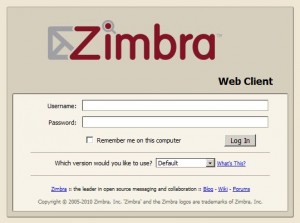What is Zimbra? (from the Zimbra website)
“… It’s an email and calendar server plus much more; think about it like a next-generation Microsoft Exchange server. In addition to email and calendar, it provides document storage and editing, instant messaging, and simplified administrative controls all in an award winning webmail user interface built with the latest AJAX web technology. ZCS also provides mobility and syncs to desktop client applications; the server is deployed on commodity Linux and Mac server hardware.”
The commercial version of Zimbra is available in several flavors including an easy to install appliance (virtual machine), and also installation packages. There is also a free community supported version, and because I only have a few mailboxes I chose to deploy the community version instead of the commercial version. Below is a step by step how to for installing the community version of Zimbra on to Ubuntu 10.04 LTS as well as a review of my experience with the product for the last several weeks.
How-to:
Note: I wanted to test the bleeding edge product so I opted for the 7.0 BETA edition of Zimbra as it doesn’t seem to suffer from high CPU usage issues like 6.0 was having. Also my production setup is Ubuntu 8.04 32 bit and version 7.0 BETA because my VMware servers are only 32bit.1.) Install Ubuntu 10.04 LTS (64-bit) on either a physical machine or in a virtual machine. You will need a minimum of 2GB of ram and about 10GB of hard drive space. Your specs will need to be scaled based on the number of users and the volume of mail that your server will handle.
2.) Visit the Zimbra website and navigate to the Community Edition download page. Download the version corresponds to the version of linux that you are using. If you would like to use the 7.0 BETA edition visit this download page and get the proper version. The easy way to download this to your new Ubuntu server is to right click the proper download link and copy the link. Then ssh into the Ubuntu server and issue the following command to download it to the server:
Note: this is a 510MB download so you may want to download this overnight if you have a slow connection.wget http://files2.zimbra.com/downloads/7.0.0_BETA2/zcs-7.0.0_BETA2_2897.UBUNTU10_64.20101102092730.tgz
3.) Extract the downloaded file
tar xzvf zcs-7.0.0_BETA2_2897.UBUNTU10_64.20101102092730.tgz
4.) Install the dependency packages
sudo apt-get install libperl5.10 sysstat sqlite3
5.) Run the Zimbra Installer
cd zcs-7.0.0_BETA2_2897.UBUNTU10_64.20101102092730
sudo ./installer.sh
6.) Answer the Installation Questions
Note: You may get some error messages about not being able to resolve your hostname. This is because whatever you made your hostname during the Ubuntu install is what Zimbra is expecting to already be configured in your DNS settings for your domain you entered. If you do not currently have MX and A records setup for your mail server do that now or just type Yes and then ignore the next error and type No to accept the host/domain name you just entered.Do you agree with the terms of the software license agreement? [N] Y
…
Select the packages to install
Install zimbra-ldap [Y] Y
Install zimbra-logger [Y] Y
Install zimbra-mta [Y] Y
Install zimbra-snmp [Y] Y
Install zimbra-store [Y] Y
Install zimbra-apache [Y] Y
Install zimbra-spell [Y] Y
Install zimbra-memcached [N] N
Install zimbra-proxy [N] N
…
The system will be modified. Continue? [N] Y
Setting defaults…No results returned for A lookup of mx1
Checked nameservers:
192.168.123.230
192.168.123.235
192.168.123.231DNS ERROR resolving mx1
It is suggested that the hostname be resolveable via DNS
Change hostname [Yes] YesPlease enter the logical hostname for this host [mx1] mx1.vmwarelab.com
No results returned for A lookup of mx1.vmwarelab.com
Checked nameservers:
192.168.123.230
192.168.123.235
192.168.123.231DNS ERROR resolving mx1.vmwarelab.com
It is suggested that the hostname be resolveable via DNS
Re-Enter hostname [Yes] No
After typing No it will ask you to change the domain name, type No again. After this you are presented with the settings that will be written to your new configuration file.
7.) The next thing we have to do is set the admin password. To do this type 3 at the following prompt:
Address unconfigured (**) items (? – help) 3
Then type 4 followed by your prefered ‘admin’ password.
8.) Next type ‘r’ to return to the previous menu then type ‘a’ to apply the new config file, there will be a few other prompts to confirm this
Select from menu, or press ‘a’ to apply config (? – help) a
Save configuration data to a file? [Yes] yes
Save config in file: [/opt/zimbra/config.7361] [Enter]
Saving config in /opt/zimbra/config.7361…done.
The system will be modified – continue? [No] yes
9.) Now we wait. Zimbra will execute some scripts that will apply the configuration we set, as well as install SSL certificates (self signed) and do many other things. This could take some time depending on what type of hardware you are running on. Be patient and dont do anything that would stop this process. (otherwise you might as well format and start over)
10.) The last thing that Zimbra’s installer will ask you is if you want to Notify Zimbra of your installation… this is totally up to you.
At this point you should be able to goto https://host.yourdomain.com:7071 and login with the username admin and the password that you set in the configuration file. You should also now be able to use Zimbra desktop to connect to your new mail server (Zimbra Desktop can be downloaded from Zimbra.com) alternatively you can access the web interface by going to http://host.yourdomain.com and logging in with admin and the same password as the admin interface.
Further administration advise can be found on the Zimbra website, or the community edition forums.
My review after using Zimbra
I have been using Zimbra for about 2 months now for some of the sites I host and I would have to say that, combined with the Zimbra Desktop client, Zimbra is a very easy to use and a very full featured collaboration package. I said collaboration and not just email app because it is so much more then just an email application. Zimbra has enabled my wife and I to start a family shared calendar, it has also enabled us to start sharing documents and indexing bills and other scanned documents with the Tags zimlet (a zimlet is a Zimbra add on feature).
Zimbra Desktop also lets me add in my Gmail account and even an IMAP connection to an Exchange account. The desktop client is coded in Java from what I can tell so it is a little heavier then a normal application… and even slightly more then Outlook 2010 in the brief check that I did. Although it doesn’t seem to be sluggish by any means.
The only issue that I have had with the Zimbra Server side of things happened when I was running version 6. My VMware servers have limited resources so I was forced to run it with only 1.5Gb of RAM, which I think contributed, but the CPU usage on the virtual machine would more often then not be at 70-90% usage. After upgrading to 7.0 BETA (which I might add was VERY easy) these problems seem to have stopped.
I am supposed to be switching from a Blackberry to an HTC Droid phone next week, so after I get comfortable with it expect a follow up article to describe how Zimbra Community Edition works with the Droid Family.
![]()





Pingback: Tweets that mention Zimbra Community Edition Howto and Review | Justin's IT Blog -- Topsy.com